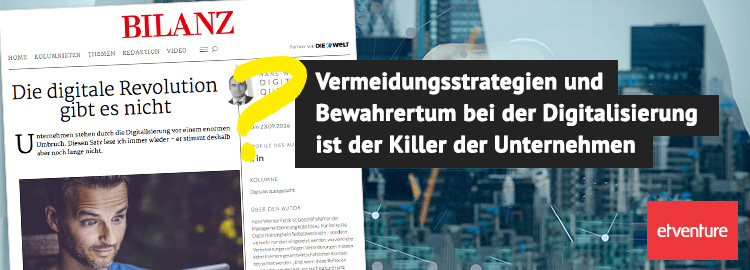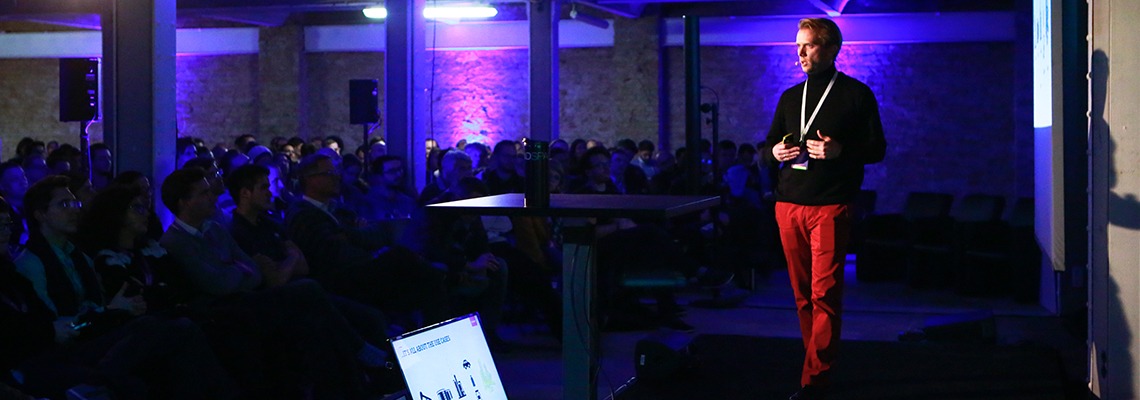No such thing as the digital revolution? Avoidance strategies and status quo mentality are deadly when it comes to digitization!
06. October 2016
“There is no such thing as the digital revolution.” That is what Hans-Werner Feick announced recently in his column on the business portal website BILANZ. All this about companies being in a huge transition because of digitization, about disruption in the ‘old economy’ because of new, agile, digital competitors – none of it is true, he says. Feick cannot see any evidence for a digital revolution. Any CEO who takes heed of these remarks and decides to take a relaxed view when it comes to digital transformation is misreading the signs of the times, is vulnerable to attack and is allowing the new competitors mentioned above to undertake the value creation. Let us explain why.
The next three years will be more decisive for the success of businesses than the last 50 years
Industry 4.0, virtual reality and artificial intelligence are already transforming all kinds of sectors and business models. There is hardly an area of life or a sector of the economy that remains unaffected by digital technology. Nevertheless, many companies are still exhibiting more of a wait-and-see attitude. Publications such as the one written by Hans-Werner Feick are likely to further reinforce these avoidance strategies and the status quo mentality. This would leave these companies in a dangerous economic position.
Not everyone is daring to take this stance. A survey of 1,500 CEOs around the world showed that 71 percent of them think that the next three years will be more decisive for the future of their respective companies than the last 50 years. Are they all on the wrong track? We have taken a closer look at the article, which is entitled ‘There is no such thing as the digital revolution.’ We want to take this opportunity to explain why we think it is Mr. Feick who is on entirely the wrong track.
– Feick: “Most of the digital idealists cite Uber and Airbnb as being digital revolutionaries. Others refer to ‘the fintechs’ that are disrupting and shaking up the old banking economy. It doesn’t ever get any more specific than that.”
It doesn’t ever get any more specific than that? Out in the marketplace, we are already seeing numerous startups and digital players who are reshaping or destroying entire markets. They are doing so by occupying the digital interface between the ‘old economy’ and clients and by implementing new business models. The most pertinent examples are the book, music, and film industries, which are now occupied by providers such as Spotify, Apple and Netflix. In recent years, the turnovers of long-established mobile phone networks have fallen by millions because customers have chosen to use free services such as WhatsApp instead of paying for phone calls and text messages. The combined market value of the four American online companies Google, Apple, Facebook and Amazon is 1.7 billion dollars. And now we come to the startups mentioned in the article, Airbnb and Uber. After its recent funding injection of just under half a billion dollars, Airbnb is now valued at 30 billion dollars. This makes it the second largest company in Silicon Valley that is not listed on the stock market. In first place is – you guessed it – the transport provider Uber. Both startups are currently fighting various legal battles with government regulations, and the prohibitive status quo mentality of the ‘old economy’ is fanning the flames. Yet at the very most, this will merely slow down the speed at which these companies are growing. If you think that companies with these kinds of investment figures and valuations can be stopped, and that the hotel and taxi industries can keep doing things the way they have always been done, you are probably living on a cloud of idealism. With around 15,000 drivers in Paris and 30,000 in New York, Uber has long been setting a precedent. It has developed a mediatory app that is clearly taking into account exactly what users want and need.
– Feick: “Although the fintech Number26 is now called N26 and has a banking license, the majority of standard banking customers are still using credit transfers and direct debits to send money.”
It is generally agreed that the invention of modern cars with combustion engines took place in 1886. Although the ‘complete replacement for the horse and carriage’ became well known beyond Germany’s borders, its potential buyers remained skeptical to begin with. The annual production figures rose from 67 cars in 1894 to 603 cars in 1900. Twenty years after the invention, there were 26,000 cars around the world and after fifty years, this figure was 800,000. Today, there are well over one billion cars. Nobody remains doubtful about whether or not the car has revolutionized transport. N26 will not need as much time. In fact, N26 is a textbook example of how, in the internet era, it is possible for the kind of company that would have taken years to build in times gone by to essentially be created out of thin air. It takes less than ten minutes to open an account with N26. The startup says it had 200,000 customers after only three years. The solution allows customers to perform all their banking transactions using a smartphone and it is particularly popular among those aged 18–35. Traditional banks have now lost these customers forever – and this is an upward trend.
– Feick: “If we’re honest, we have to admit that this technological leap that will lead to an absolutely outstanding change dynamic – it is nowhere to be seen. 3D printers will not replace mass production.”
This sentence is completely incorrect on two counts. When discussing digitization, many people talk about Industry 4.0 – intelligent factories, for example. But this is just one aspect of digitization. It is not just about technology. It is about accessing new areas of business by using digital interfaces to reach clients. This needs to happen because for specific products that have been developed to perfection, such as machines or systems, the market is shrinking (see also the report in Der Spiegel about etventure and the SMS group entitled ‘Pain Points Everywhere’ [in German]). It is about implementing a digital channel with which to contact clients, in order to avoid the scenario that is common in many sectors: A startup fills the gap between companies and clients and the company becomes reliant on the startup. And the following figures about steel distributor Klöckner offer a concrete example. With the help of etventure, the company tackled the challenge of digital transformation in 2014. By 2015, it had 100 million euros of revenue coming in via digital channels and for 2016 the figure will be 650 million.
To say that 3D printing will not replace mass production is another daring assertion. Perhaps it will not completely replace mass production, but it will surely affect it in a significant way. Already we are seeing that the possibilities are limitless. This year, the first house made up of 3D-printed components was built in Dubai – in just 19 days. Shoes that fit, bicycles, missing components – it will all be produced by 3D printers. The medical sector is carrying out intensive research into 3D printing procedures for organs. If that’s not revolutionary…
– Feick: “Driverless cars are still a long way off“
Considering the current competition surrounding driverless cars, it is incomprehensible that anyone could say that they are ‘a long way off.’ This technology has been a reality for some time now! In Silicon Valley, researchers are working against the clock to develop the driverless car. In March this year, it was announced that Google is running a fleet of 20 driverless cars. Up to that point, the fleet had already covered a distance of more than two million kilometers in automatic mode. Other competitors include Apple, Tesla, and Uber – yes, Uber again. In August, the company announced that it had signed a deal worth 300 million dollars with the automobile manufacturer Volvo. They said they planned to work together to develop a fully autonomous car by 2021. But the traditional automobile industry has also been testing driverless cars for a while now. According to an announcement made last year, Daimler plans to have developed a driverless car by as early as 2020. In any case, it is less than five years until driverless cars reach the mass market.
– Feick: “Artificial intelligence and robot technology will not result in thousands of people losing their jobs.”
Let us hope he’s right in this respect, at least. But it is legitimate to ask the question: What will happen to the salespeople, administrators and factory workers whose manual processes will undeniably be automated? Today’s digital natives will no longer be answering the door to representatives from insurance companies. Insurance claims and legal cases will be evaluated and sorted using algorithms. Factory machines will automatically order replacement parts. Taxis will be completely automated – and it won’t stop with cars! This will affect all kinds of transportation vehicles, from lorries to cargo ships. There have been studies that reach contradictory conclusions about the effect this will have on the number of jobs. We think that the human factor will continue to be crucial to digitization. Yet it is also a fact that one of the greatest challenges related to digitization is that of training people and ensuring that they are not left behind by this process.
– Feick: I could be controversial and say that the large IT providers and IT consultants have got us into this digital pit – just so they can then offer their services to help get us out of it.
Without trying to be controversial, we would say that anyone who assigns their IT department with the task of digitization will fail. The main task of the head of IT is to ensure that the IT infrastructure keeps working perfectly and to keep improving it. And this is a very important task. Yet for digitization, the main things that are required are exceedingly rapid product development, a radical focus on users and data, a culture of failure, and disruption. Most of this clashes with the DNA of any IT department. The tendency as we see it is that IT consultancies have actually missed the boat with this trend. The current focus is on new employee profiles. For some companies this is a CDO, for etventure it is digital entrepreneurs. In their respective companies, these employees establish new leadership models and introduce new methods and approaches. This kickstarts the transformation of the company’s culture. There is, however, another aspect that should not be forgotten. For potential employees, companies that pay no attention to forward-looking technologies and developments are not attractive employers.
Our conclusion is that, if they were printed out, the arguments against the digital revolution that are presented in this article would not be worth the paper they were printed on.
Of course these changes will not take place overnight. But that is not the characteristic feature of a revolution. The more important features are speed (of development), reach, and a systemic impact. The ‘old industry’ has already undergone three waves of renewal. It began with human force being applied to machines. It continued with the automated production line and then opened its doors to robotics and computing technology. It now needs to master the fourth transformation, which is taking place exponentially rather than linearly. Daimler wants to remain Daimler, without becoming a clone of Google. Siemens and all of the other industrial giants are also well aware that they must never lose their grip on the management of production processes or customer relationships. This means that, although digitization is often just seen as an opportunity, for this sector it must be seen as necessary for the renewal of industrialized society. This sentiment is echoed by a recent issue of Handelsblatt: “German industry can only remain the way it is at the cost of its own demise.”
– Feick: “The art is to see digitization as an instrument and to use it correctly for its purposes.”
We have also identified something positive from the article – we agree with this statement. Yet companies that do not apply this instrument – and here we return to where we started – will be pushed aside and will be leaving the value creation to others. The next three years will be more important than the previous 50 years.
Hans-Werner Feick is the CEO of the management consultancy kobaltblau. He draws from nearly 30 years of experience as an IT management consultant to comment on digitization – according to his bio on the BILANZ website. At this point, we would like to inform you that Philipp Depiereux, Founder & Managing Director of etventure, also writes a regular column about digitization for BILANZ. You are warmly invited to read his views on the BILANZ website.





* Required field